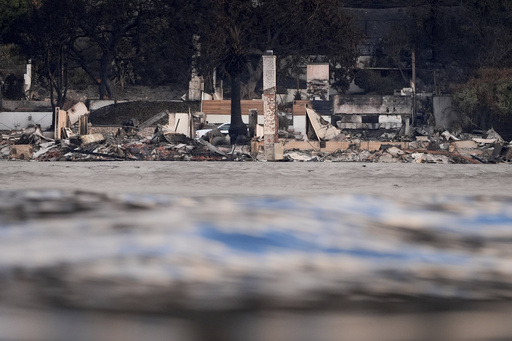
LOS ANGELES — Recently, Tracy Quinn took a drive down the scenic Pacific Coast Highway to evaluate the damage caused by the Palisades Fire along the coastline.
The water appeared tainted with ash, and remnants of household appliances like washing machines and dryers littered the shore. The shoreline was covered in sludge, while waves during high tide encroached upon burnt residences, pulling debris and potentially hazardous ash into the ocean.
“It was just heartbreaking,” remarked Quinn, the president and CEO of the environmental organization Heal the Bay, whose team has detected ash and debris as far as 25 miles south of the Palisades burn zone near Los Angeles.
As cleanup crews endeavor to remove potentially huge amounts of hazardous materials left by the LA wildfires, scientists and officials are examining the extent to which the land fires have affected marine environments.
The Palisades and Eaton fires devastatingly affected numerous homes, businesses, vehicles, and electronics, converting everyday items into toxic ash that contains harmful substances like pesticides, asbestos, plastics, lead, and various heavy metals.
Given the possibility that much of the debris could flow into the Pacific Ocean, there are mounting concerns about the unknown effects these fires may have on marine life.
“We haven’t seen a concentration of homes and buildings burned so close to the water,” Quinn added.
There are worries that ash and toxic debris could render the water hazardous for surfers and swimmers, especially after rainfall that washes chemicals, garbage, and other dangers into the sea.
Longer-term, scientists express concern over how these urban pollutants could have a critical impact on the marine food chain.
The recent atmospheric river and mudslides that hit the Los Angeles area have intensified these apprehensions.
When the fires first ignited in January, Mara Dias, the water quality manager for the Surfrider Foundation, immediate worry was the risk of ocean water contamination. Strong winds had been carrying smoke and ash far from the fire sites, leading to potential sea pollution.
Researchers aboard a scientific vessel during the fire events found ash and debris as far as 100 miles offshore, marine ecologist Julie Dinasquet from the University of California, San Diego’s Scripps Institution of Oceanography noted.
The materials they collected included various natural debris and emitted a smell reminiscent of burning electronics, rather than a pleasant campfire aroma.
Rain runoff presents another critical and urgent issue. Rain can carry contaminants and waste into the ocean through an intricate network of drainage systems and rivers. Dias explained how this runoff could introduce a variety of harmful nutrients—such as nitrogen and phosphate—often found in the ash from burned materials. Heavy metals and polycyclic aromatic hydrocarbons (PAHs), which are released when different fuels burn, also pose a danger.
Mudslides and debris flows from the Palisades Fire burn area may further exacerbate the situation by adding more hazardous waste to the ocean. After a fire, the soil in areas scarred by fire becomes less capable of absorbing rainfall, developing a water-repelling layer due to the remnants of burned organic matter. This can significantly increase the chance of mudslides and debris flows.
Officials in Los Angeles County, along with various agencies, have erected thousands of feet of concrete barriers, sandbags, and silt socks to prevent debris from polluting local beaches.
Recently, the LA County Board of Supervisors approved a motion seeking additional support from state and federal entities to enhance beach clean-up efforts, prepare for storm runoff, and test ocean waters for toxins and pollutants.
In addition to routine water quality sampling, state water officials are now examining samples for various heavy metals, including arsenic, lead, and aluminum, as well as volatile organic compounds.
The sampling also targets microplastics, PAHs, and polychlorinated biphenyls (PCBs)—synthetic chemicals linked to severe health issues like cancer in animals—which have been banned from production but were once commonly used in paints and electrical equipment.
Public health officials in the county reported that water tests conducted last month did not indicate serious health risks, leading them to downgrade one beach closure to an advisory for ocean water. Beach patrons are still advised to avoid entering the water.
Dinasquet and her team are meticulously researching how far potentially hazardous ash and debris has spread across the ocean, as well as how quickly it sinks and finally settles.
Forest fires can yield beneficial nutrients like iron and nitrogen to ocean ecosystems, enhancing phytoplankton growth, which can have a beneficial ripple effect. Conversely, the toxic ash from urban fires holds the potential for devastating consequences, Dinasquet explained.
“There are already reports indicating significant lead and asbestos concentrations in the ash,” she stated. “This poses serious threats to humans, and it’s likely equally harmful to marine organisms.”
A paramount concern is whether harmful contaminants from the fires will infiltrate the food chain. Researchers plan to analyze fish tissue for traces of heavy metals and other pollutants. However, they cautioned that comprehending the wider impacts of a large-scale urban fire on overall ecosystems and food supply will take time.
Dias emphasized that the ocean has always absorbed land-based pollution, yet the compounded effects of fires and other disasters intensify the urgency of the situation.

